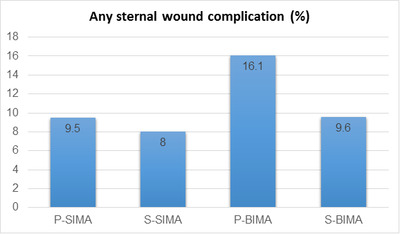Benedetto, Umberto, Altman, Douglas G., Gerry, Stephen, Gray, Alastair, Lees, Belinda, Pawlaczyk, Rafal, Flather, Marcus and Taggart, David P. and Arterial Revascularization Trial investigators (2016) Pedicled and skeletonized single and bilateral internal thoracic artery grafts and the incidence of sternal wound complications: Insights from the Arterial Revascularization Trial. Journal of Thoracic and Cardiovascular Surgery, 152 (1). pp. 270-276. ISSN 0022-5223
Preview |
PDF (Accepted manuscript)
- Accepted Version
Available under License Creative Commons Attribution Non-commercial No Derivatives. Download (442kB) | Preview |
Preview |
Image (TIFF) (Figure 1_SKE_ART)
- Accepted Version
Download (86kB) | Preview |
![[thumbnail of Figure 2_ART_SKE]](https://ueaeprints.uea.ac.uk/64261/5.hassmallThumbnailVersion/Figure_2_ART_SKE.png)  Preview |
Image (PNG) (Figure 2_ART_SKE)
- Accepted Version
Download (11kB) | Preview |
Abstract
Objectives: The question of whether skeletonized internal thoracic artery harvesting reduces the incidence of sternal wound complications in comparison with the pedicled technique, in the context of single or bilateral internal thoracic arteries, remains controversial. We studied the impact of the internal thoracic artery harvesting strategy on sternal wound complication in the Arterial Revascularization Trial. Methods: Patients enrolled in the Arterial Revascularization Trial (n = 3102) were randomized to coronary artery bypass grafting with single or bilateral internal thoracic arteries. Sternal wound complication rates were examined according to the harvesting technique that was documented in 2056 patients. The internal thoracic artery harvesting technique, based on the surgeon's preference, resulted in 4 groups: pedicled single internal thoracic artery (n = 607), pedicled bilateral internal thoracic artery (n = 459), skeletonized single internal thoracic artery (n = 512), and skeletonized bilateral internal thoracic artery (n = 478). Propensity scores weighting was used to estimate the impact of the harvesting technique on sternal wound complications. Results: A total of 219 of 2056 patients (10.6%) experienced a sternal wound complication within 1 year from the index operation. Of those, only 25 patients (1.2%) required sternal wound reconstruction. Pedicled bilateral internal thoracic artery (odds ratio [OR], 1.80; 95% confidence interval [CI], 1.23-2.63) but not skeletonized bilateral internal thoracic artery (OR, 1.00; 95% CI, 0.65-1.53) or skeletonized single internal thoracic artery (OR, 0.89; 95% CI, 0.57-1.38) was associated with a significantly increased risk of any sternal wound complications compared with pedicled single internal thoracic artery. Conclusions: The present Arterial Revascularization Trial substudy suggests that, with a skeletonization technique, the risk of sternal wound complication with bilateral internal thoracic artery grafting is similar to that after standard pedicled single internal thoracic artery harvesting, whereas skeletonized single internal thoracic artery harvesting did not add any further benefit when compared with pedicled single internal thoracic artery harvesting.
| Item Type: | Article |
|---|---|
| Uncontrolled Keywords: | coronary artery bypass grafting,bilateral internal thoracic arteries,sternal wound infection |
| Faculty \ School: | Faculty of Medicine and Health Sciences > Norwich Medical School |
| UEA Research Groups: | Faculty of Medicine and Health Sciences > Research Groups > Cardiovascular and Metabolic Health Faculty of Medicine and Health Sciences > Research Groups > Norwich Clinical Trials Unit Faculty of Medicine and Health Sciences > Research Groups > Public Health and Health Services Research (former - to 2023) Faculty of Medicine and Health Sciences > Research Centres > Metabolic Health |
| Depositing User: | Pure Connector |
| Date Deposited: | 26 Jul 2017 05:04 |
| Last Modified: | 16 Oct 2025 14:32 |
| URI: | https://ueaeprints.uea.ac.uk/id/eprint/64261 |
| DOI: | 10.1016/j.jtcvs.2016.03.056 |
Downloads
Downloads per month over past year
Actions (login required)
 |
View Item |

 Tools
Tools Tools
Tools